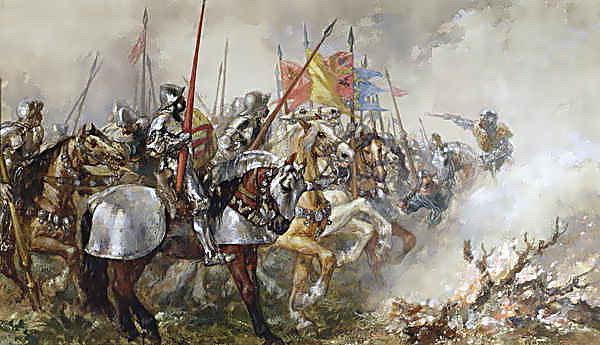
The hundred years war was comprised of a series of conflicts between England and France between 1337 and 1453. The war started because the Dukes of Acquintane and Burgandy were also Lords of territories were also lord’s of territories beyond the Kingdom of France which made them richer than the French King. There was also a succession crisis that took place in the Kingdom of France. Charles IV who was the last of three royal sons of King Phillip IV died without any sons. After his death, Phillip of Valois who was the eldest nephew of Phillip IV claimed the throne but so did Edward III of England whose mother was Isabella, daughter of King Phillip. Inheritance law at that time in France and England would have granted the kingdom to King Edward but because the kingdom of france was at that time the largest, most populous and richest realm, the supreme court rejected the claims of King Edward and awarded the Kingdom to Valois [1].
This led to a series of conflicts starting in 1337 when King Edward challenged Valois to a trial by combat [2]. This is generally seen amongst modern historians as the first phase of the war and the Plataneget party was triumphant in the first phase [3].
King Charles V started the second phase of the war from 1360 to 1413 and he regained most of the territory his father had lost. The Valois recovery of control initiated by King Charles weakened after his death and furthermore because of the feud between the Duke of Burgandy and his first cousin the Duke of Orleans. In 1407, the Duke of Orleans was assassinated by an agent of the Duke of Burgandy. The royalist Valois faction led by Count Bernad VII of Armagnac sought revenge and they took on the name ‘’The Armagnacs.’’ This is where the Armagnac-Burgandy rivalry stemmed from [4].
The third Phase lasted from 1413 to 1428 until the Siege of Orleans [5]. The third phase lasted from when King Henry V invaded France and was hugely victorious and dictated the terms of the Treaty of Troyes [6]. The main terms of the Treaty of Troyes were that King Charles would remain king for his lifetime but that at his death the crown of France would go to King Henry and his heirs [7]. This provision disinherited Charles V and he fled Bourges in the centre of France [8]. He kept trying to regain control of the kingdom but his efforts were almost always refuted. At this point, the French were losing until Joan of Arc entered the fray. She inspired the victory in Orleans which led to anointing and coronation of King Charles [9].
Even if Joan of Arc was captured by the heads of the Anglo-Burgandian alliance, they were unable to derail the French military recovery that she had started [10]. Four years later, the treaty of Arras took place in 1935 [11]. This treaty sealed the end of the Burgandian alliance with the English [12]. It also led to the end of the Armagnac-Burgandian civil war [13].
By: ERNEST MWESIGYE
Works cited
1.Pernoud, Régine, Marie-Veronique Clin, and Jeremy DuQuesnay Adams. Joan of Arc: her story. London: Phoenix, 2000.
2. Ibid.
3. Ibid.
4. Ibid.
5. Ibid.
6. Ibid.
7. Curry, Anne . Two Kingdoms, One King: The creation of a double mornachy of England and France.
8. Ibid.
9. Ibid.
10. Ibid.
11. Ibid.
12. Lesaffer, Randall. “THE CONCEPTS OF WAR AND PEACE IN THE FIFTEENTH CENTURIES TREATIES OF ARRAS.” https://pure.uvt.nl/portal/files/324511/CONCEPTS.PDF
13. Ibid.
BIBLIOGRAPHY
Allmand, C. T. The Hundred Years War: England and France at war c.1300-c. 1450. Cambridge: Cambridge University Press, 2005.
Burne, Alfred Higgins. The Agincourt War: a military history of the Hundred Years War from 1369 to 1453. London: Greenhill Books, 1991.
DeVries, Kelly. Joan of Arc: a military leader. Stroud: History, 2011.
Gordon, Mary. Joan of Arc: a life. New York: Penguin Books, 2008.
